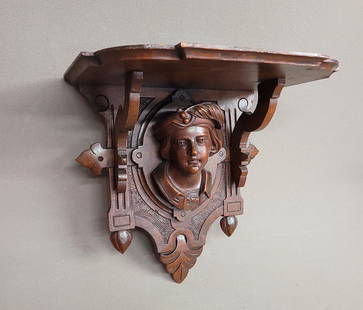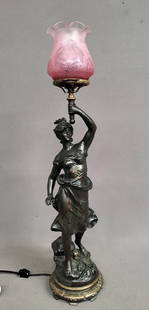
ALEXANDER CALDER, Trepied, 1972
Similar Sale History
View More Items in Sculptures & CarvingsRelated Sculptures & Carvings
More Items in Sculptures & Carvings
View MoreRecommended Art
View More


Item Details
Description
Trepied, 1972
painted metal 112 1/4 x 118 1/4 x 124 in. (285.1 x 300.4 x 315 cm) Initialed and dated "AC 72" on the metal element.
PROVENANCE Galerie Maeght, Paris Private Collection Sale: Sotheby's, New York, Contemporary Art Evening Sale, May 18, 1999, lot 24 Acquired at the above sale by the present owner
LITERATURE Alexander Calder: Retrospective, Galerie Maeght, Zurich, 1973, no. 27 (illustrated)
EXHIBITED Zurich, Galerie Maeght, Alexander Calder: Retrospective, May – July, 1973 Goslar, Germany, Mönchehaus-Museum für Moderne Kunst, Kaiserring Prize, 1977 Vienna Neustadt, Europa Skulptur, 1997
sculpture should be viewed. Though it is obvious in the figures above, each foot should be observed as two separate figures, regardless of their structural nature. Calder used color in the same way that a painter of canvas does—to delineate shapes from shapes. Again, we see his visionary genius refuse to be confined within the realms of only two or three dimensions. Instead, he combines tenets of both, delivering the viewer an adventure of exploration in seeking out the many components of his work. Above, suspended on the ends of a single metal branch, nearly neutral in its stately silver, we see a colorful balance of varying figures. On one side, we observe a majestic quadrilateral, bright yellow in its hue and massive in its weight. The unequal sides of this powerful figure help it to resist any convenient geometric labels, and lending it unique personality as it hangs over our heads. Equalizing the massy excitement on the opposite end, a joyous conglomeration of shapes bustles with conversation and hangs calmly, balanced perfectly by the yellow giant. While Calder's blue figure resembles a brother form to the yellow quadrilateral, the other three shapes are unique in the sculpture: a smaller black triangle proclaims the highest point in the mobile, while the two round circles below it, one bright white and the other same hue as the sculpture's red trunk. However, as we observe Calder's sculpture in a state of relative calm, we must remember that with any breeze or gust of wind, it will cease to conform to its current orientation, turning and bending in an effort to once again achieve equilibrium. As the piece sets itself back into its original formation of balance, it stands poised to receive another hit, bouncing back into new shapes with a kinetic joy. One of the most enticing features of Trepied, 1972, is the fact that all of its movements are dependent upon sheer chance. While a child on his father's shoulders could push the many facets of the mobile into motion, even a tiny subtlety such as a room's air circulation could initiate the sculpture's imbalance, giving new movement to the present lot's limbs. In the same way that he possesses supreme control of the full range of a specific work's production, Calder releases all control of his work once the final surface has been painted or surface has been welded. What he gives over is a breathing expression of fate, one that will always continue to move according to ever evolving factors of its environment. The nature of the current lot's potential for movement also endows it with a potential for performance. Enmeshed with and fascinated by dance in 1920s and 1930s Paris, Calder designed sets for seminal choreographer Martha Graham and composer Eric Satie. In turn, this joy of movement came to saturate each of mobiles; Calder chose to imbue each of his creations with a spirit of movement and a future of motion. Calder's early plans for his Mechanical Ballet reveal the sense of life that he desired to bequeath his artistic subjects: "Calder allowed his true ambition for theatrical productions to emerge: he wanted to dispense with any action onstage other than that of his animated forms, which would then no longer merely serve as decorative sets or props. Rather, he wanted the presence of his work to replace every other presence, especially live actors and dancers. Calder thus endorsed a course that the avant-garde theater has been pursuing since the 1910s: the actor was depersonalized, mechanized, and, ultimately, replaced by a theatrical mechanism, a 'performance-machine'" (A. Pierre, "Staging Movement", Marla Prather, ed., Alexander Calder: 1898-1976, Washington DC, 1998, p. 343). By the time he created the present lot in 1972, he had been making theatre out of sculpture for nearly thirty years, and, in the perfect balance of Calder's many metallic limbs, we see the flawless poise and elegant movement that only a dancer can replicate. If the viewer were to push sideways the heavy yellow extremity of Trepied, 1972, the result would be a dance of perfection: rotating around their shared fulcrum, Calder's branches seem to slide along an invisible plain, their faultless equilibrium a testament to the equal weight on both sides. However, if one were to pull down the same side, then release the figure into the sky above, he would observe a semblance of choreography on the opposite side, the shapes moving upwards and downwards in order to accommodate the alternating weights applied by the viewer. This series of movements paired with the travelling movement of the branch engenders a veritable amusement park of rotating figures and arms. Gazing upon Calder's thrilling movement, one cannot help but smile at the mobile's character, as entertaining as it is mesmerizing. In the end, the present lot is a full-scale, self-contained theatrical production, one "presented both as [a painting] in movement and as [a spectacle] staged in [a small theatre], in which the movement of forms is the object of the productions and serves as the subject of the performances" (A. Pierre, "Staging Movement", Marla Prather, ed., Alexander Calder: 1898-1976, Washington DC, 1998, p. 339). The importance of Calder's art was not only in its nature of movement, but also in its absolute dearth of pretension. In crafting his sculptures from simple sheet metal, Calder chose to make content rather than medium the main subject in his work. Calder's choice of material, compounded with his bold steps into unexplored regions of sculpture, proved him to be the Twentieth Century's most progressive sculptor and an artist whose art had universal appeal, devoid of any esoteric or elitist elements. As we embrace the artistic modernity of the Twenty-First Century, we are in Calder's debt. As we see in Trepied, 1972, Calder was loyal to the spirit of artistic progression until the very end of his career. Witnessing the gracious, humorous, and often surprising movement of the limbs of the present lot, we remember that profundity is not always enmeshed in utter complexity; for meaning can exist in the most modest of sculptures instilled with the most simple vitality. "I feel an artist should go about his work simply with great respect for his materials…sculptors of all places and climates have used what came ready at hand. They did not search for exotic and precious materials. It was their knowledge and invention which gave value to the result of their labors… simplicity of equipment and an adventurous spirit in attacking the unfamiliar or unknown" (Alexander Calder, 1943, "Alexander Calder", Calder Foundation, New York, 1943 taken from Simplicity of Means: Calder and the Devised Object, New York, 2007)
Ο
painted metal 112 1/4 x 118 1/4 x 124 in. (285.1 x 300.4 x 315 cm) Initialed and dated "AC 72" on the metal element.
PROVENANCE Galerie Maeght, Paris Private Collection Sale: Sotheby's, New York, Contemporary Art Evening Sale, May 18, 1999, lot 24 Acquired at the above sale by the present owner
LITERATURE Alexander Calder: Retrospective, Galerie Maeght, Zurich, 1973, no. 27 (illustrated)
EXHIBITED Zurich, Galerie Maeght, Alexander Calder: Retrospective, May – July, 1973 Goslar, Germany, Mönchehaus-Museum für Moderne Kunst, Kaiserring Prize, 1977 Vienna Neustadt, Europa Skulptur, 1997
sculpture should be viewed. Though it is obvious in the figures above, each foot should be observed as two separate figures, regardless of their structural nature. Calder used color in the same way that a painter of canvas does—to delineate shapes from shapes. Again, we see his visionary genius refuse to be confined within the realms of only two or three dimensions. Instead, he combines tenets of both, delivering the viewer an adventure of exploration in seeking out the many components of his work. Above, suspended on the ends of a single metal branch, nearly neutral in its stately silver, we see a colorful balance of varying figures. On one side, we observe a majestic quadrilateral, bright yellow in its hue and massive in its weight. The unequal sides of this powerful figure help it to resist any convenient geometric labels, and lending it unique personality as it hangs over our heads. Equalizing the massy excitement on the opposite end, a joyous conglomeration of shapes bustles with conversation and hangs calmly, balanced perfectly by the yellow giant. While Calder's blue figure resembles a brother form to the yellow quadrilateral, the other three shapes are unique in the sculpture: a smaller black triangle proclaims the highest point in the mobile, while the two round circles below it, one bright white and the other same hue as the sculpture's red trunk. However, as we observe Calder's sculpture in a state of relative calm, we must remember that with any breeze or gust of wind, it will cease to conform to its current orientation, turning and bending in an effort to once again achieve equilibrium. As the piece sets itself back into its original formation of balance, it stands poised to receive another hit, bouncing back into new shapes with a kinetic joy. One of the most enticing features of Trepied, 1972, is the fact that all of its movements are dependent upon sheer chance. While a child on his father's shoulders could push the many facets of the mobile into motion, even a tiny subtlety such as a room's air circulation could initiate the sculpture's imbalance, giving new movement to the present lot's limbs. In the same way that he possesses supreme control of the full range of a specific work's production, Calder releases all control of his work once the final surface has been painted or surface has been welded. What he gives over is a breathing expression of fate, one that will always continue to move according to ever evolving factors of its environment. The nature of the current lot's potential for movement also endows it with a potential for performance. Enmeshed with and fascinated by dance in 1920s and 1930s Paris, Calder designed sets for seminal choreographer Martha Graham and composer Eric Satie. In turn, this joy of movement came to saturate each of mobiles; Calder chose to imbue each of his creations with a spirit of movement and a future of motion. Calder's early plans for his Mechanical Ballet reveal the sense of life that he desired to bequeath his artistic subjects: "Calder allowed his true ambition for theatrical productions to emerge: he wanted to dispense with any action onstage other than that of his animated forms, which would then no longer merely serve as decorative sets or props. Rather, he wanted the presence of his work to replace every other presence, especially live actors and dancers. Calder thus endorsed a course that the avant-garde theater has been pursuing since the 1910s: the actor was depersonalized, mechanized, and, ultimately, replaced by a theatrical mechanism, a 'performance-machine'" (A. Pierre, "Staging Movement", Marla Prather, ed., Alexander Calder: 1898-1976, Washington DC, 1998, p. 343). By the time he created the present lot in 1972, he had been making theatre out of sculpture for nearly thirty years, and, in the perfect balance of Calder's many metallic limbs, we see the flawless poise and elegant movement that only a dancer can replicate. If the viewer were to push sideways the heavy yellow extremity of Trepied, 1972, the result would be a dance of perfection: rotating around their shared fulcrum, Calder's branches seem to slide along an invisible plain, their faultless equilibrium a testament to the equal weight on both sides. However, if one were to pull down the same side, then release the figure into the sky above, he would observe a semblance of choreography on the opposite side, the shapes moving upwards and downwards in order to accommodate the alternating weights applied by the viewer. This series of movements paired with the travelling movement of the branch engenders a veritable amusement park of rotating figures and arms. Gazing upon Calder's thrilling movement, one cannot help but smile at the mobile's character, as entertaining as it is mesmerizing. In the end, the present lot is a full-scale, self-contained theatrical production, one "presented both as [a painting] in movement and as [a spectacle] staged in [a small theatre], in which the movement of forms is the object of the productions and serves as the subject of the performances" (A. Pierre, "Staging Movement", Marla Prather, ed., Alexander Calder: 1898-1976, Washington DC, 1998, p. 339). The importance of Calder's art was not only in its nature of movement, but also in its absolute dearth of pretension. In crafting his sculptures from simple sheet metal, Calder chose to make content rather than medium the main subject in his work. Calder's choice of material, compounded with his bold steps into unexplored regions of sculpture, proved him to be the Twentieth Century's most progressive sculptor and an artist whose art had universal appeal, devoid of any esoteric or elitist elements. As we embrace the artistic modernity of the Twenty-First Century, we are in Calder's debt. As we see in Trepied, 1972, Calder was loyal to the spirit of artistic progression until the very end of his career. Witnessing the gracious, humorous, and often surprising movement of the limbs of the present lot, we remember that profundity is not always enmeshed in utter complexity; for meaning can exist in the most modest of sculptures instilled with the most simple vitality. "I feel an artist should go about his work simply with great respect for his materials…sculptors of all places and climates have used what came ready at hand. They did not search for exotic and precious materials. It was their knowledge and invention which gave value to the result of their labors… simplicity of equipment and an adventurous spirit in attacking the unfamiliar or unknown" (Alexander Calder, 1943, "Alexander Calder", Calder Foundation, New York, 1943 taken from Simplicity of Means: Calder and the Devised Object, New York, 2007)
Ο
Buyer's Premium
- 25% up to $50,000.00
- 20% up to $1,000,000.00
- 12% above $1,000,000.00
ALEXANDER CALDER, Trepied, 1972
Estimate $5,000,000 - $7,000,000
16 bidders are watching this item.
Shipping & Pickup Options
Item located in New York, NY, usSee Policy for Shipping
Payment

Related Searches
TOP

































![Alexander Calder-Style Sculpture: Miniature red painted ovoid metal sculpture, in the manner of Alexander Calder. The base of one rail is impressed "AC 90". [17 1/2" H x 10 1/2" W x 12" D]. Few paint chips to edges.](https://p1.liveauctioneers.com/1221/91347/46664979_1_x.jpg?height=310&quality=70&version=1468855222)














































